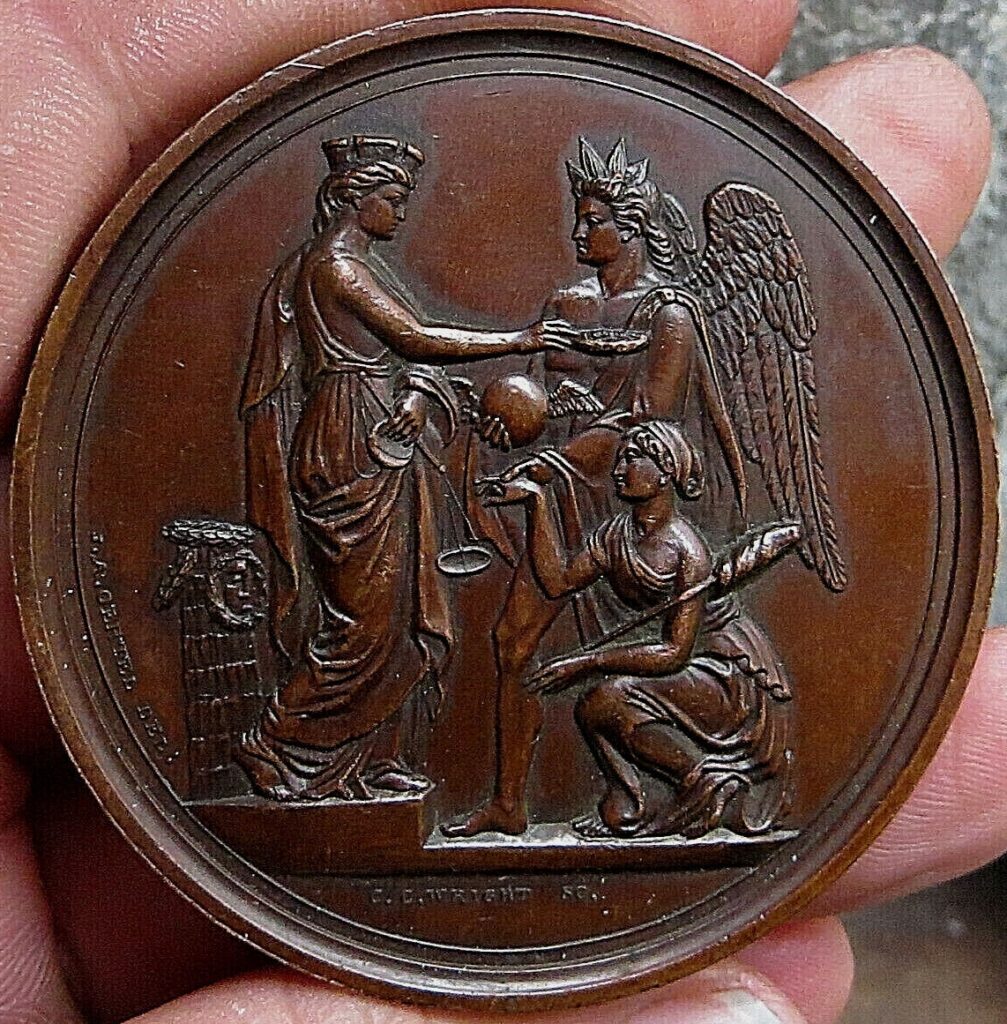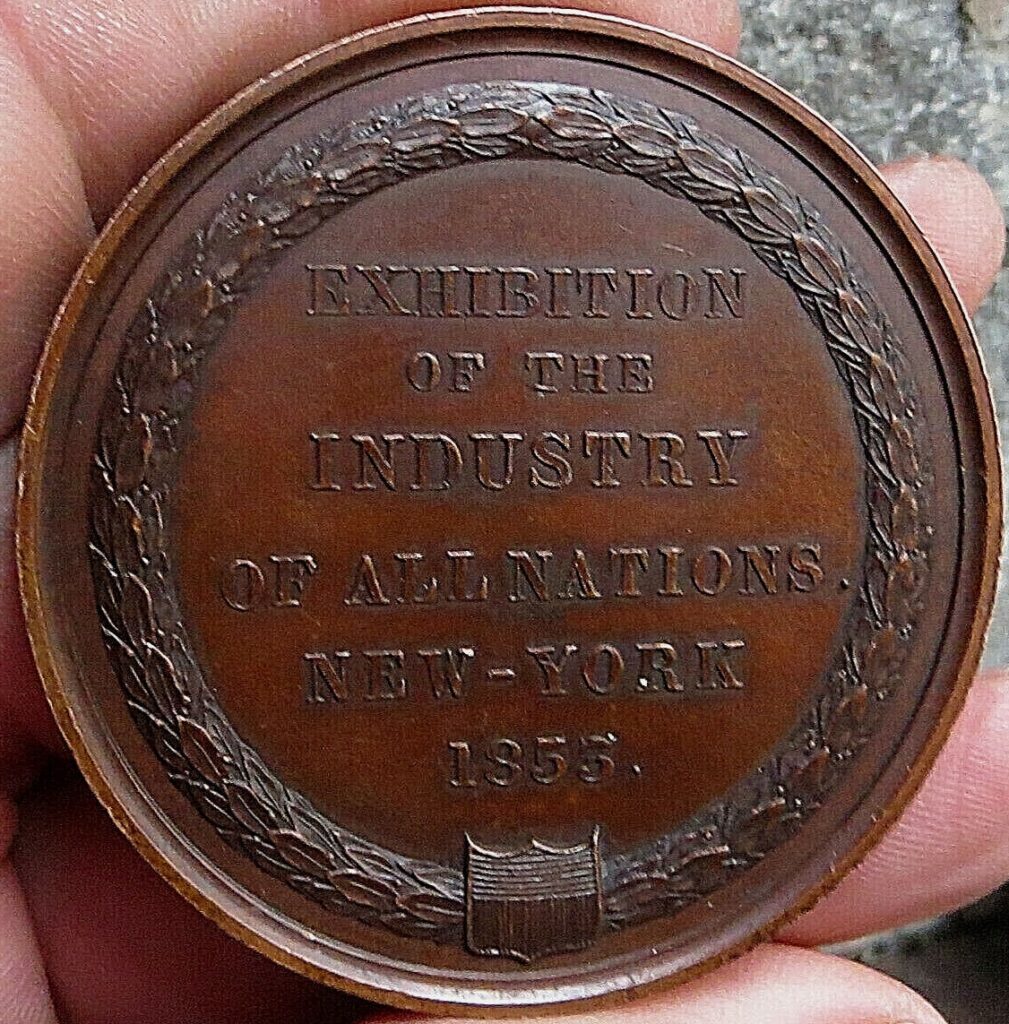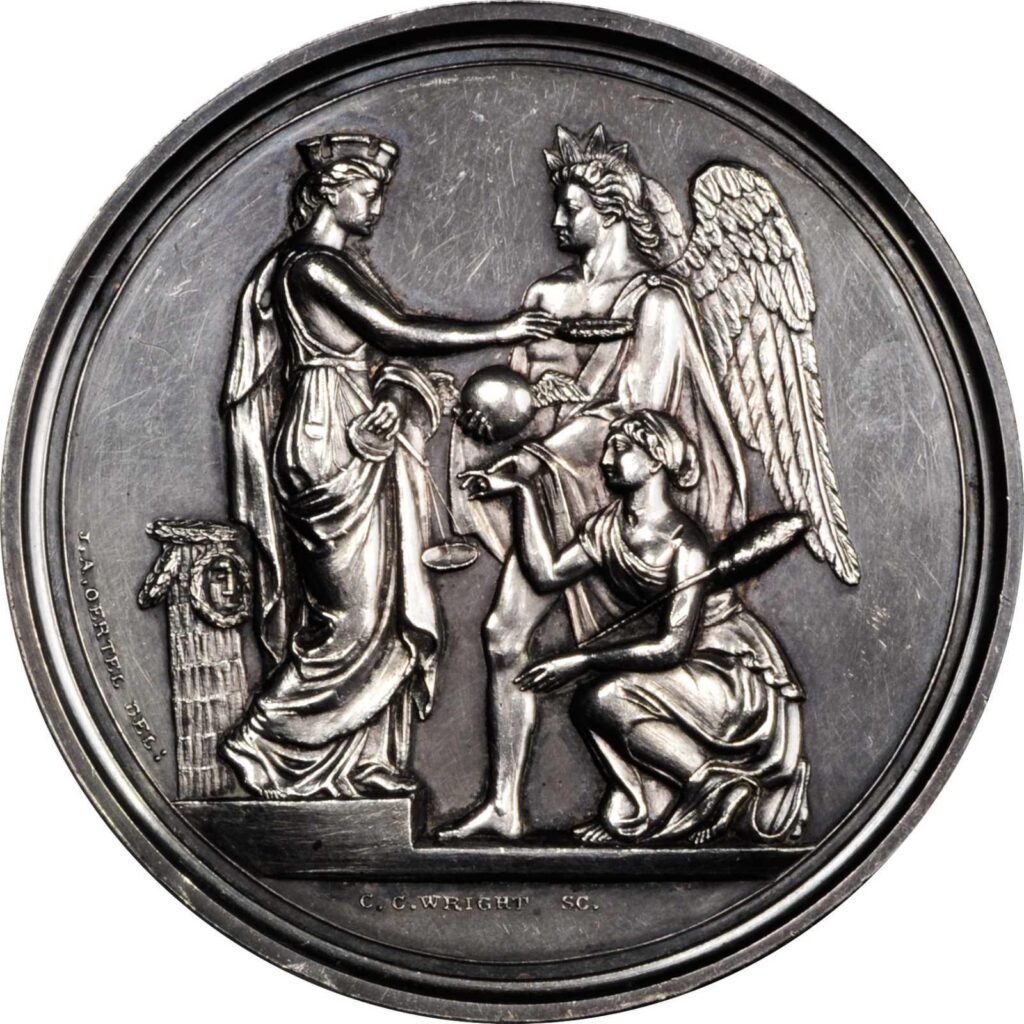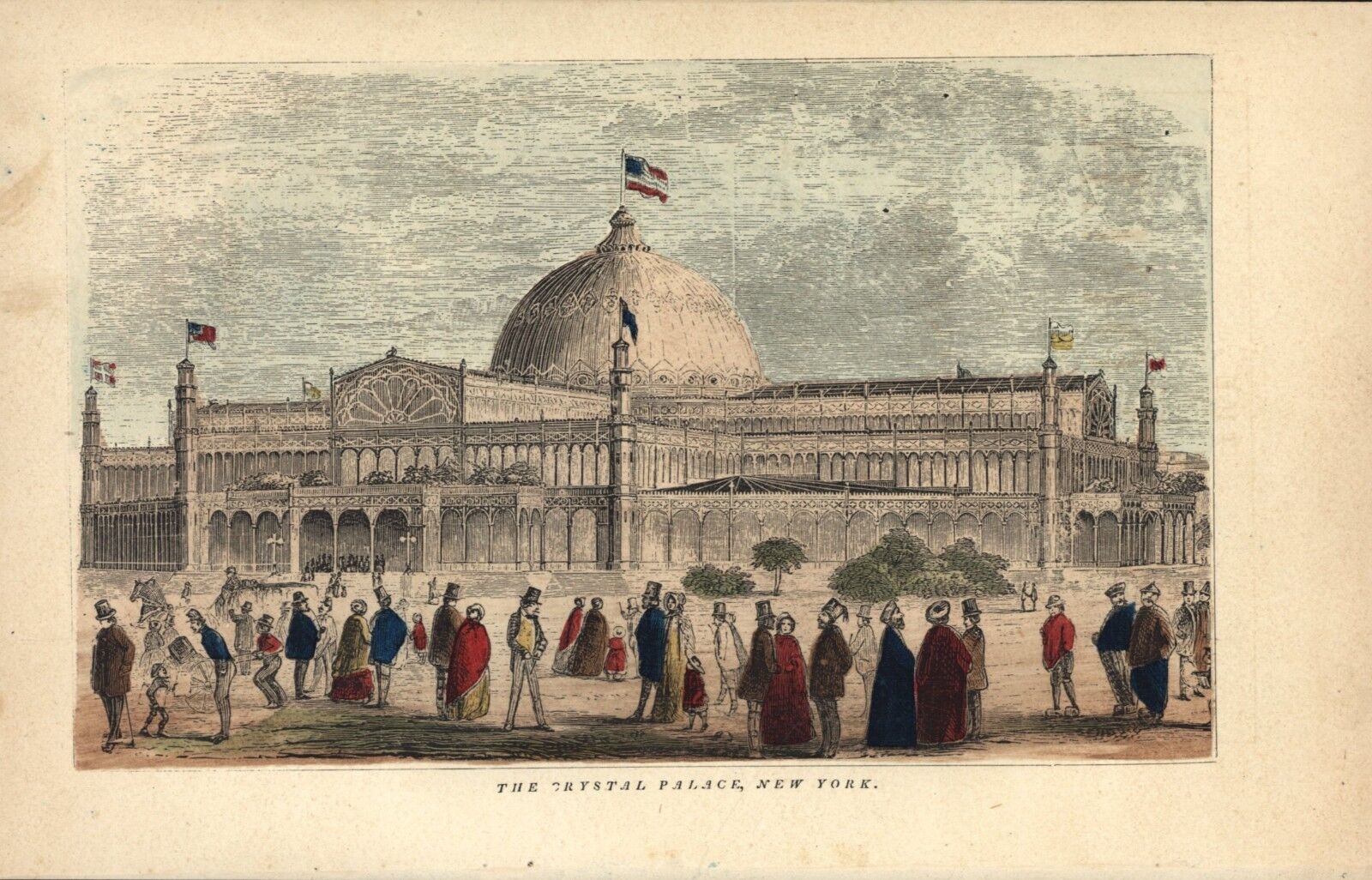1853 New York World’s Fair Medals – Industry of All Nations (original) (raw)
THIS NEW YORK OFFICAL EXPOSITON, WORLD’S FAIR OR EXHIBITION AS THIS ONE WAS CALLED, WAS THE FIRST IN THE COUNTRY. IT WAS THE 1853 CRYSTAL PALACE IN NEW YORK, TAKING ITS NAME FROM LONDON’S SPECTACULAR BUILDING THAT HOUSED THAT FIRST WORLD’S FAIR.
The president of the Association for the Exhibition of Industry of All Nations was the famous P.T. Barnum. Tiffany & Co. was awarded a silver medal. Because no gold medals were awarded at the fair, the silver medal was given only for originality of design, invention, or discovery, coupled with skill of fabrication and excellence of material.2 The organizers and juries of the awards followed the precedent of the Great Exhibition in London, where there were two classes of medals—silver and bronze—and an honorable mention. In New York, a total of 115 silver medals were awarded; 1,186 bronze medals; and 1,210 exhibitors received an honorable mention.
1853 New York World’s Fair Medals
The image below shows a bronze award medal from the 1853 New York World’s Fair, known as the International Exhibition of the Industry of All Nations. The medal’s obverse features a classical allegorical scene with three figures, likely representing the arts, industry, and commerce, which were common themes in the iconography of the time.
In the center stands a robed female figure, symbolic of America, holding a laurel wreath and a cornucopia, both traditional emblems of prosperity and abundance. To her right is a seated figure with wings, possibly representing Mercury, the Roman god of commerce, or an embodiment of progress, holding a caduceus, which is often associated with trade and negotiation. On the left, another female figure, possibly representing the arts, is depicted pouring out coins from a small bag, suggesting the wealth generated by industry and the rewards of innovation.
These figures are finely detailed, standing against a backdrop that includes a fasces to the far left, a bundle of rods with an axe, symbolizing unity and authority. The overall design celebrates the industrial and cultural achievements highlighted by the World’s Fair.

1853 BRONZE AWARD MEDAL NEW YORK EXPOSITION
Bronze or Copper Medal approx. 56mm , 93gr , by JA OERTEL del CC WRIGHT SC. The obverse is described above. exhibits a rich chocolate patina, a characteristic that adds depth and warmth to its appearance. The artist’s signature reads, ” J.A.OERTEL DEL: C.C.C WRIGHT SC.”

1853 BRONZE AWARD MEDAL NEW YORK EXPOSITION
The reverse of the 1853 New York World’s Fair medal is elegantly simple, emphasizing the event’s title within a central, unadorned field: “EXHIBITION OF THE INDUSTRY OF ALL NATIONS NEW-YORK 1853.” The text is inscribed in clear, capitalized letters, making it the focal point of the design. Encircling the inscription is a wreath, finely detailed, consisting of leaves and possibly berries, which traditionally symbolize victory and success. The wreath is an emblematic feature often found in medals, framing the content and signifying the honor bestowed upon the recipient. The overall design is enclosed within a beaded border, adding a refined finish to the medal’s circumference. The preservation of such detail, alongside the medal’s chocolate patina, reflects the craftsmanship of the era and the significance of this commemorative piece.

1853 SILVER AWARD MEDAL NEW YORK EXPOSITION
EXHIBITION OF THE INDUSTRY OF ALL NATIONS NEW-YORK 1853. 57.5 mm. 77.5 grams. By Charles Cushing Wright. Julian AM-16. This is one of the 125 silver award medals. I would love one of these for my collection, but only 125 issued, chances are slim.
The 1853 New York World’s Fair, also known as the Exhibition of the Industry of All Nations, was an event designed to showcase the technological and cultural achievements of the time. In an era driven by innovation and progress, the fair presented an array of awards to honor those who were leading the charge in various fields.
Medal Award Categories:
The awards at the 1853 fair were divided into several categories, reflecting the broad scope of industries and arts present. Some of these categories likely included:
Manufacturing: Recognizing advancements in the production of goods, from textiles to machinery.
Agriculture: Honoring innovations in farming techniques and equipment, as well as superior produce and livestock.
Fine Arts: Awards for painters, sculptors, and other artists who contributed to the cultural richness of the fair.
Inventions: Singling out the most groundbreaking inventions that promised to shape the future.
Commerce: Acknowledging contributions to trade and the expansion of the global market.
Architecture and Engineering: Celebrating excellence in the design and construction of structures that combined aesthetics with functionality.
Criteria for Medal Recipients:
How Were Medal Winners Determined?
The recipients of these awards were determined based on a set of criteria that assessed:
Innovation: The originality and novelty of the entry.
Utility: The usefulness and practicality of the application.
Craftsmanship: The quality and skill demonstrated in the creation of the product or work.
Design: The aesthetic appeal and functionality of the design.
Impact: The potential or actual benefit to the public or industry.
Spotlight Stories:
Some Notable Medal Winners at New York Exposition
One notable recipient might have been Elisha Otis, who dramatically demonstrated his safety elevator at the fair, halting it between floors to show that it wouldn’t fall even if the lifting rope was cut. This not only earned him an award but also set the stage for the skyscraper era in urban architecture.
Another spotlight could shine on the contributions of Jordan Mott, who won awards for his advancements in iron stoves, which greatly improved efficiency and safety in heating and cooking, changing domestic life significantly.
In the realm of agriculture, John Deere’s innovative steel plow, which effectively cut through the heavy Midwest soil, might have been a recipient, showcasing the impact of agricultural innovations on America’s growth.
Tiffany & Co. was awarded a silver medal. At the Crystal Palace, Tiffany won a silver medal “for elaborately wrought Classical Silverware and Jewelry of superior design and execution.”
Article: “And the Silver Medal goes to…”: Awards at the New York Crystal Palace by Ana Estrades
These stories not only highlight the individual contributions but also paint a picture of an era in which the United States was rapidly transforming, fueled by the spirit of ingenuity that these medals sought to recognize and encourage.
You may be interested in another New York exposition: 1901 Pan American Exposition Award Medals – Buffalo NY
What Special Attractions Were Showcased at 1853 NY World’s Fair?
The Crystal Palace: Modeled after the Crystal Palace from the 1851 London Exhibition, the New York version was an architectural marvel of its time, made of iron and glass. It housed the exhibits and was an attraction in itself. Also see Crystal Place Medals page by American Numismatic Society
International Pavilions: Different nations had their pavilions or areas where they showcased their unique products, arts, and crafts. This included luxury goods such as fine porcelains, silks, and furniture.
Share Your Medal Pictures –
Do you own a piece of history? If you’re the proud owner of an 1853 New York World’s Fair medal, we invite you to share your treasure with us. Whether it’s a stunning silver medal or an “Honorable Mention” accolade, your piece is a fragment of the past waiting to be showcased. We’re particularly eager to hear the stories behind your medals, the journey they’ve taken to reach you, and any details that make them unique.
Please send us high-resolution photographs of your 1853 medals, along with any fascinating history or personal anecdotes associated with them. If you have an Honorable Mention or a rare silver medal, we’re especially interested in featuring these items. Your contributions will not only enrich our collective understanding of the 1853 World’s Fair legacy but also provide a digital archive for fellow enthusiasts to admire and learn from.
Contact us through the Privacy Link at the bottom right of this page.